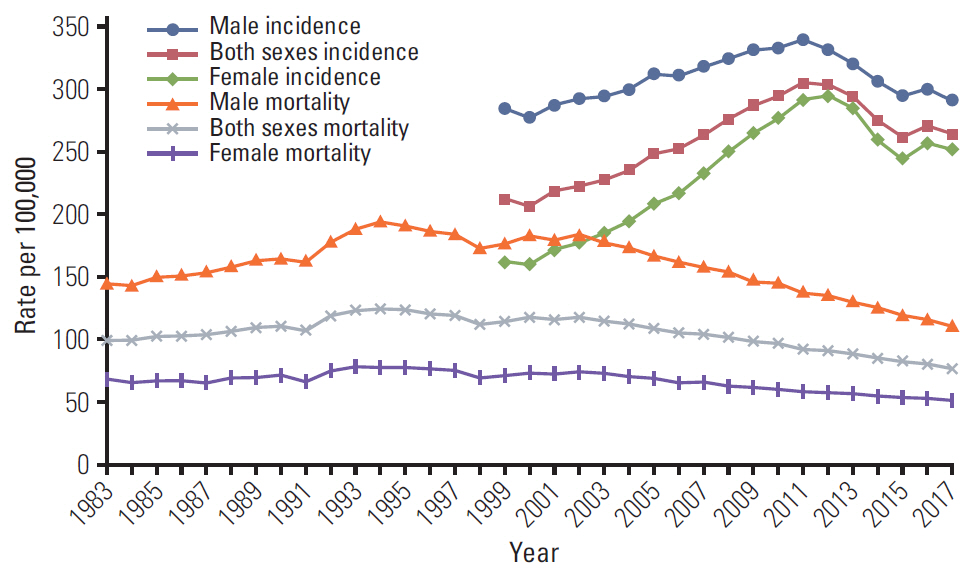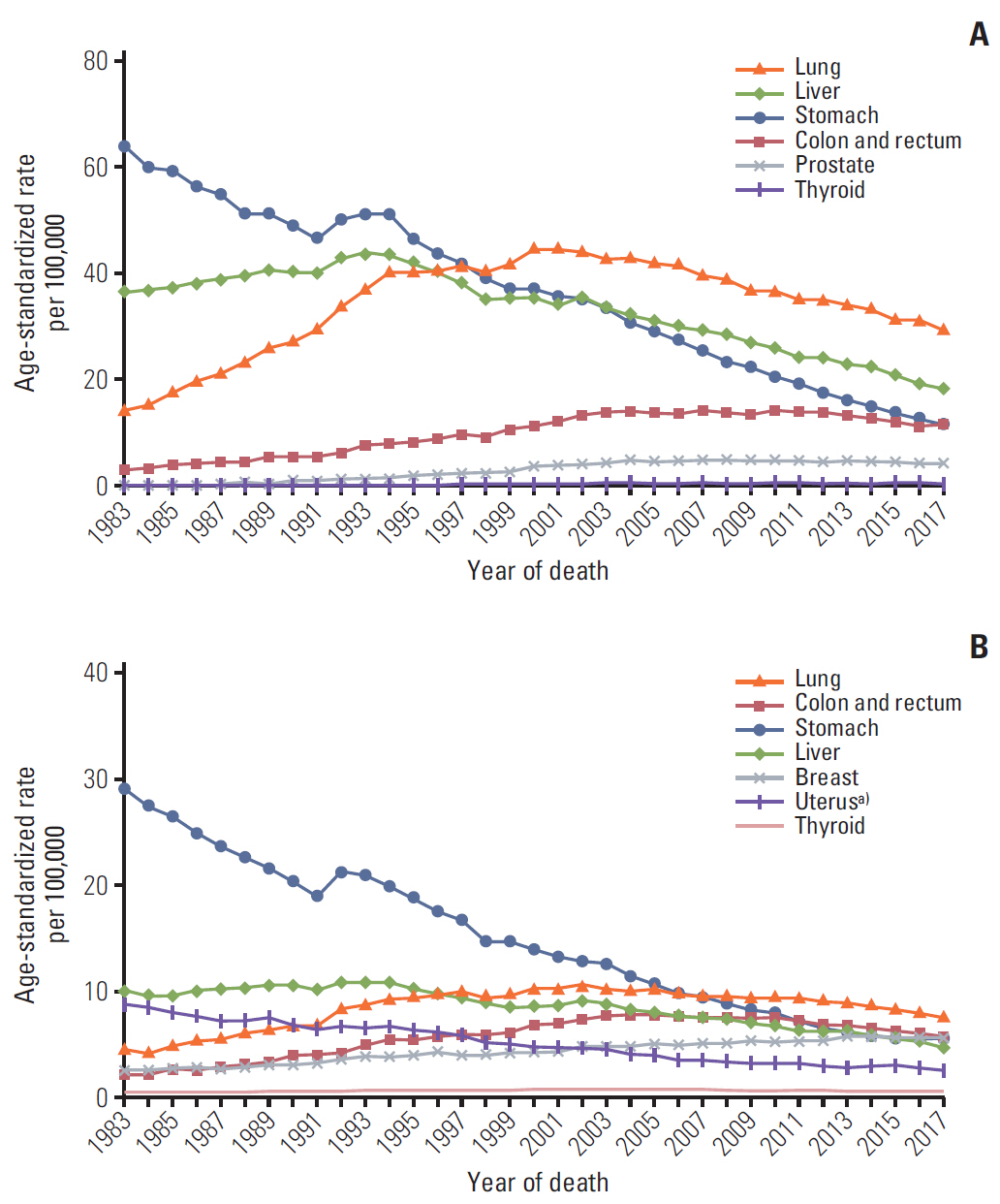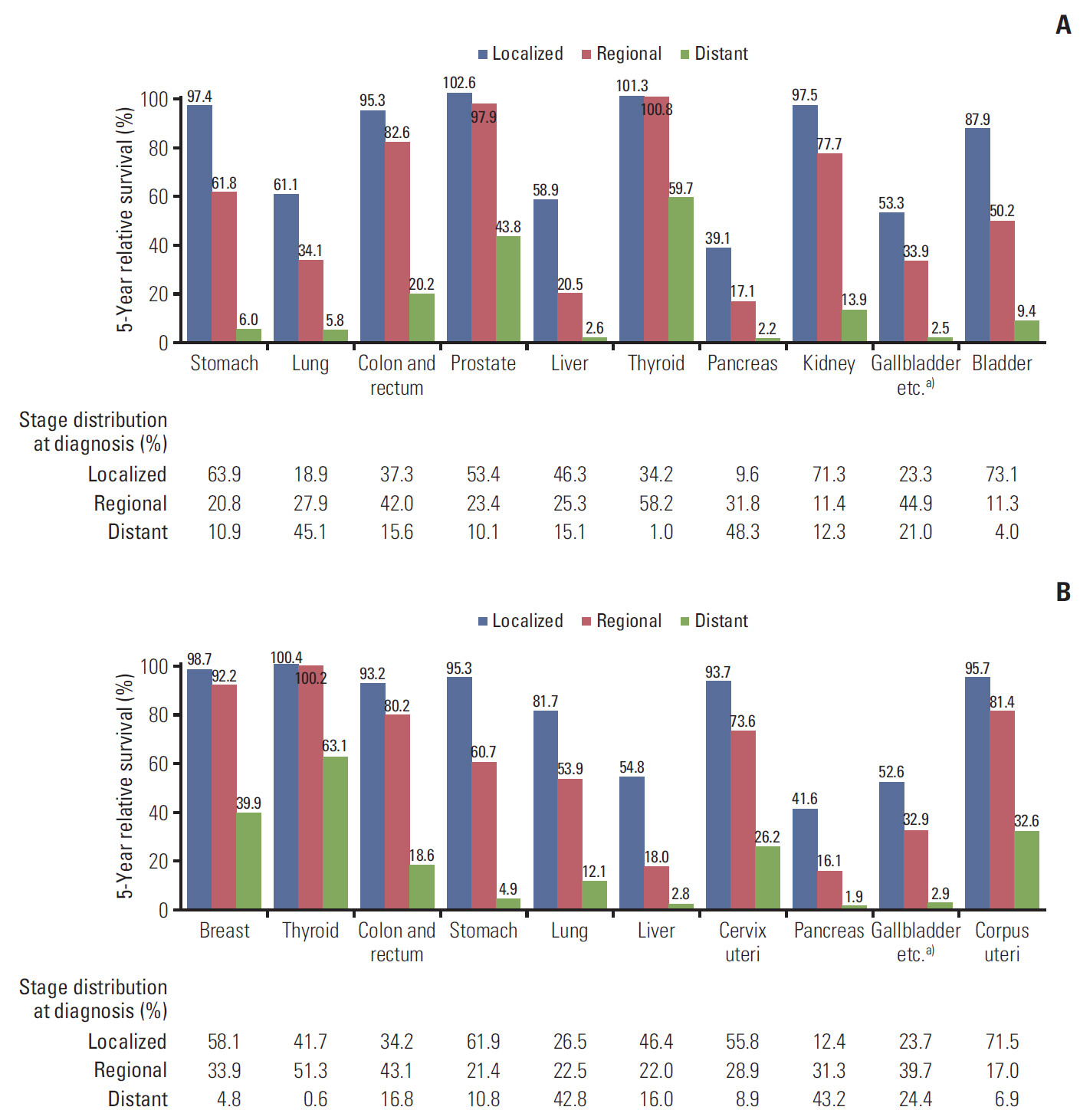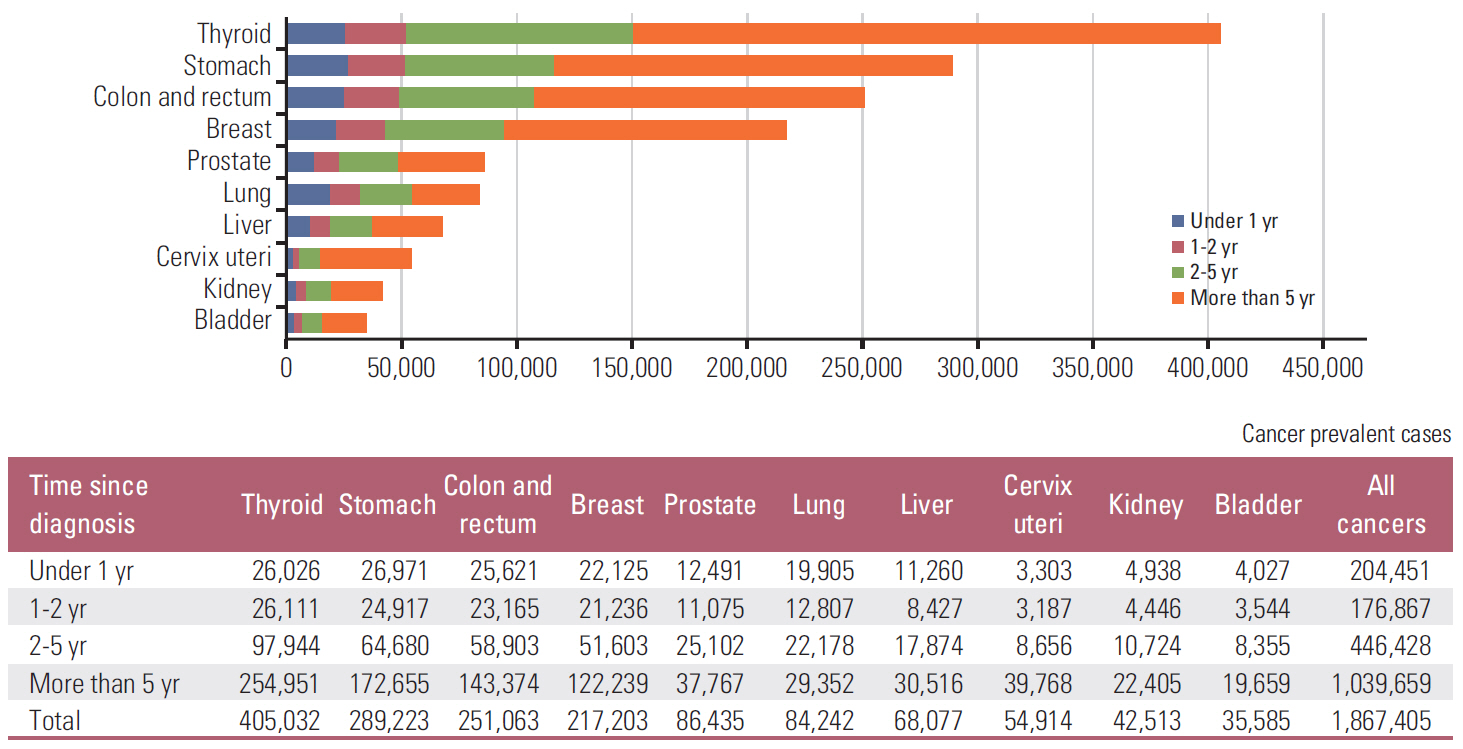Cancer Statistics in Korea: Incidence, Mortality, Survival, andPrevalence in 2017
- Affiliations
-
- 1Korea Central Cancer Registry, National Cancer Center, Goyang, Korea
- 2Division of Cancer Registration and Surveillance, National Cancer Control Institute, National Cancer Center, Goyang, Korea
- 3Department of Cancer Control and Population Health, National Cancer Center Graduate School of Cancer Science and Policy, National Cancer Center, Goyang, Korea
- 4National Cancer Center Graduate School of Cancer Science and Policy, National Cancer Center, Goyang, Korea
- KMID: 2500319
- DOI: http://doi.org/10.4143/crt.2020.206
Abstract
- Purpose
This study reports the cancer statistics and temporal trends in Korea on a nationwide scale, including incidence, survival, prevalence, and mortality in 2017.
Materials and Methods
The incidence, survival, and prevalence rates of cancer were evaluated using data from the Korea National Cancer Incidence Database from 1999 to 2017 with follow-up until December 31, 2018. Deaths from cancer were assessed using cause-of-death data from 1983 to 2017, obtained from Statistics Korea. Crude and age-standardized rates (ASRs) for incidence, mortality, and prevalence, and 5-year relative survival rates were calculated and trend analysis was performed.
Results
In 2017, newly diagnosed cancer cases and deaths from cancer numbered 232,255 (ASR, 264.4 per 100,000) and 78,863 (ASR, 76.6 per 100,000), respectively. The overall cancer incidence rates increased annually by 3.5% from 1999 to 2011 and decreased by 2.7% annually thereafter. Cancer mortality rates have been decreasing since 2002, by 2.8% annually. The 5-year relative survival rate for all patients diagnosed with cancer between 2013 and 2017 was 70.4%, which contributed to a prevalence of approximately 1.87 million cases by the end of 2017.
Conclusion
The burden of cancer measured by incidence and mortality rates have improved in Korea, with the exception of a few particular cancers that are associated with increasing incidence or mortality rates. However, cancer prevalence is increasing rapidly, with the dramatic improvement in survival during the past several years. Comprehensive cancer control strategies and efforts should continue, based on the changes of cancer statistics.
Figure
Cited by 30 articles
-
Trends of Incidence and Survival Rates of Mucosa-associated Lymphoid Tissue Lymphoma in the Korean Population: Analysis of the Korea Central Cancer Registry Database
Seok-Hoo Jeong, Shin Young Hyun, Ja Sung Choi, Hee Man Kim
J Korean Med Sci. 2020;35(36):e294. doi: 10.3346/jkms.2020.35.e294.Implications of Radiotherapy Utilization in Korea from 2010 to 2019
Jeongshim Lee, Woo Chul Kim, Won Sup Yoon, Chai Hong Rim
J Korean Med Sci. 2021;36(18):e117. doi: 10.3346/jkms.2021.36.e117.Changes in Korean National Healthcare Insurance Policy and Breast Cancer Surgery Trend in Korea
Musaed Rayzah, Jai Min Ryu, Jun-Hee Lee, Seok Jin Nam, Seok Won Kim, Se Kyung Lee, Jonghan Yu, Kyeong-Tae Lee, Sa-Ik Bang, Goo-Hyun Mun, Jai-Kyong Pyon, Byung-Joon Jeon, Jeong Eon Lee
J Korean Med Sci. 2021;36(29):e194. doi: 10.3346/jkms.2021.36.e194.The incidence and survival of cervical, ovarian, and endometrial cancer in Korea, 1999-2017: Korea Central Cancer Registry
Hyeong In Ha, Ha Kyun Chang, Soo Jin Park, Jiwon Lim, Young-Joo Won, Myong Cheol Lim
Obstet Gynecol Sci. 2021;64(5):444-453. doi: 10.5468/ogs.21116.Comparison of clinicopathological characteristics and prognosis in breast cancer patients with different Breast Imaging Reporting and Data System categories
Bong Kyun Kim, Jai Min Ryu, Se Jeong Oh, Jaihong Han, Jung Eun Choi, Joon Jeong, Young Jin Suh, Jina Lee, Woo Young Sun,
Ann Surg Treat Res. 2021;101(3):131-139. doi: 10.4174/astr.2021.101.3.131.Analysis of risk factors associated with survival in human epidermal growth factor receptor 2-positive ductal carcinoma
in situ using Korean Breast Cancer Society Database
Sol Ji Ahn, Chang Ik Yoon, Pill Sun Paik, Tae-Kyung Yoo, Namsun Park, Eun Sook Lee, Jung Eun Choi, Joon Jeong, Hyun Jo Youn, Woo-Chan Park
Ann Surg Treat Res. 2021;101(6):315-321. doi: 10.4174/astr.2021.101.6.315.MicroRNA-552 expression in colorectal cancer and its clinicopathological significance
Joon Im, Soo Kyung Nam, Hye Seung Lee
J Pathol Transl Med. 2021;55(2):125-131. doi: 10.4132/jptm.2021.01.17.Metastatic gastric cancer of the testis diagnosed through urine cytology
Mee Sook Roh, Song-Hee Han
J Pathol Transl Med. 2021;55(4):303-305. doi: 10.4132/jptm.2021.04.19.Clinicopathologic features of cutaneous metastases from internal malignancies
Hyeong Mok Kwon, Gyu Yeong Kim, Dong Hoon Shin, Young Kyung Bae
J Pathol Transl Med. 2021;55(4):289-297. doi: 10.4132/jptm.2021.05.24.Second Primary Ovarian Epithelial, Fallopian Tube, and Primary Peritoneal Cancers after Breast Cancer Diagnosis: Korea Central Cancer Registry
Hyeong In Ha, Eun-Gyeong Lee, Jiwon Lim, So-Youn Jung, Yoon Jung Chang, Young-Joo Won, Myong Cheol Lim
Cancer Res Treat. 2021;53(2):541-548. doi: 10.4143/crt.2020.1001.Pulmonary Metastasectomy in Colorectal Cancer: A Population-Based Retrospective Cohort Study Using the Korean National Health Insurance Database
Woo Sik Yu, Mi Kyung Bae, Jung Kyu Choi, Young Ki Hong, In Kyu Park
Cancer Res Treat. 2021;53(4):1104-1112. doi: 10.4143/crt.2020.1213.Current Trends in the Quality Assessment of Colorectal Cancer Practice and Treatment in South Korea during 2012–2017
Kyu Hye Choi, Jin Ho Song, Hong Seok Jang, Sung Hwan Kim, Jong Hoon Lee
Cancer Res Treat. 2021;53(2):487-496. doi: 10.4143/crt.2020.623.Genetic Susceptibility of ACE2 and TMPRSS2 in Six Common Cancers and Possible Impacts on COVID-19
Tung Hoang, Trung Quang Nguyen, Tho Thi Anh Tran
Cancer Res Treat. 2021;53(3):650-656. doi: 10.4143/crt.2020.950.Prediction of Cancer Incidence and Mortality in Korea, 2021
Kyu-Won Jung, Young-Joo Won, Seri Hong, Hyun-Joo Kong, Jeong-Soo Im, Hong Gwan Seo
Cancer Res Treat. 2021;53(2):316-322. doi: 10.4143/crt.2021.290.Hypofractionated Radiotherapy for Early-Stage Breast Cancer: A Propensity Score Matched Analysis
Anbok Lee, Hee Yeon Kim, Tae Hyun Kim, Ki Jung Ahn, Heunglae Cho, Sung Kwang Park, Yunseon Choi
J Korean Med Sci. 2022;37(8):e64. doi: 10.3346/jkms.2022.37.e64.Korean Surgical Practice Guideline for Pancreatic Cancer 2022: A summary of evidence-based surgical approaches
Seung Eun Lee, Sung-Sik Han, Chang Moo Kang, Wooil Kwon, Kwang Yeol Paik, Ki Byung Song, Jae Do Yang, Jun Chul Chung, Chi-Young Jeong, Sun-Whe Kim
Ann Hepatobiliary Pancreat Surg. 2022;26(1):1-16. doi: 10.14701/ahbps.22-009.Gynecologic cancer clinical practice guidelines in Korea and current issues
Jeeyeon Kim, Joo-Hyuk Son, Tae-Wook Kong, Suk-Joon Chang
Korean J Women Health Nurs. 2022;28(2):83-86. doi: 10.4069/kjwhn.2022.05.10.Trends in the Performance of the Korean National Cancer Screening Program for Gastric Cancer from 2007 to 2016
Ji Eun Ryu, Eunji Choi, Kyeongmin Lee, Jae Kwan Jun, Mina Suh, Kyu Won Jung, Kui Son Choi
Cancer Res Treat. 2022;54(3):842-849. doi: 10.4143/crt.2021.482.Selection Strategies and Practical Application of
BRAF V600E-Mutated Non–Small Cell Lung Carcinoma
Inwoo Hwang, Yoon-La Choi, Hyunwoo Lee, Soohyun Hwang, Boram Lee, Hobin Yang, Chaithanya Chelakkot, Joungho Han
Cancer Res Treat. 2022;54(3):782-792. doi: 10.4143/crt.2021.843.Various types of reconstruction after pancreaticoduodenectomy for the patients who underwent all types of gastrectomy: a single-enter experience
Hyun-Jeong Jeon, Hyung-Jun Kwon, Yoon-Jin Hwang, Sang Geol Kim
Ann Surg Treat Res. 2022;102(6):323-327. doi: 10.4174/astr.2022.102.6.323.Trend Analysis and Prediction of Hepatobiliary Pancreatic Cancer Incidence and Mortality in Korea
Hyeong Min Park, Young-Joo Won, Mee Joo Kang, Sang-Jae Park, Sun-Whe Kim, Kyu-Won Jung, Sung-Sik Han
J Korean Med Sci. 2022;37(28):e216. doi: 10.3346/jkms.2022.37.e216.Safety of performing distal pancreatosplenectomy in patients who underwent distal gastrectomy previously: a multicenter cohort analysis with systematic literature review
Sung Eun Park, Kwang Yeol Paik, Dong Do You, Tae Yoon Lee, Kee-Hwan Kim, Gun Hyung Na, Jung Hyun Park, Tae Ho Hong
Ann Surg Treat Res. 2022;103(3):145-152. doi: 10.4174/astr.2022.103.3.145.Diagnostic distribution and pitfalls of glandular abnormalities in cervical cytology: a 25-year single-center study
Jung-A Sung, Ilias P. Nikas, Haeryoung Kim, Han Suk Ryu, Cheol Lee
J Pathol Transl Med. 2022;56(6):354-360. doi: 10.4132/jptm.2022.09.05.A Systematic Review of Economic Evaluation of Thyroid Cancer
Mijin Kim, Woojin Lim, Kyungsik Kim, Ja Seong Bae, Byung Joo Lee, Bon Seok Koo, Eun Kyung Lee, Eu Jeong Ku, June Young Choi, Bo Hyun Kim, Sue K. Park
Int J Thyroidol. 2022;15(2):74-104. doi: 10.11106/ijt.2022.15.2.74.Epidemiology of Second Non-breast Primary Cancers among Survivors of Breast Cancer: A Korean Population–Based Study by the SMARTSHIP Group
Haeyoung Kim, Su SSan Kim, Ji Sung Lee, Jae Sun Yoon, Hyun Jo Youn, Hyukjai Shin, Jeong Eon Lee, Se Kyung Lee, Il Yong Chung, So-Youn Jung, Young Jin Choi, Jihyoung Cho, Sang Uk Woo
Cancer Res Treat. 2023;55(2):580-591. doi: 10.4143/crt.2022.410.A Nationwide Study of Differences in Surgical Treatment Rates and Oncological Outcomes for Prostate Cancer according to Economic Status and Region
Sangjun Yoo, Sohee Oh, Min Chul Cho, Hwancheol Son, Hyeon Jeong
Cancer Res Treat. 2023;55(2):652-658. doi: 10.4143/crt.2022.893.Cost-Effectiveness of Active Surveillance Compared to Early Surgery of Small Papillary Thyroid Cancer: A Retrospective Study on a Korean Population
Han-Sang Baek, Jeonghoon Ha, Kwangsoon Kim, Jaseong Bae, Jeong Soo Kim, Sungju Kim, Dong-Jun Lim, Chulmin Kim
J Korean Med Sci. 2023;38(34):e264. doi: 10.3346/jkms.2023.38.e264.Temporal Trend in Uptake of the National General Health Checkups and Cancer Screening Program among Korean Women with Breast Cancer
Thi Xuan Mai Tran, Soyeoun Kim, Chihwan Cha, Boyoung Park
Cancer Res Treat. 2024;56(2):522-530. doi: 10.4143/crt.2023.729.Korean National Burden of Disease: The Importance of Diabetes Management
Chung-Nyun Kim, Yoon-Sun Jung, Young-Eun Kim, Minsu Ock, Seok-Jun Yoon
Diabetes Metab J. 2024;48(4):518-530. doi: 10.4093/dmj.2024.0087.A 10-Gene Signature to Predict the Prognosis of Early-Stage Triple-Negative Breast Cancer
Chang Min Kim, Kyong Hwa Park, Yun Suk Yu, Ju Won Kim, Jin Young Park, Kyunghee Park, Jong-Han Yu, Jeong Eon Lee, Sung Hoon Sim, Bo Kyoung Seo, Jin Kyeoung Kim, Eun Sook Lee, Yeon Hee Park, Sun-Young Kong
Cancer Res Treat. 2024;56(4):1113-1125. doi: 10.4143/crt.2024.100.
Reference
-
References
1. Bray F, Ferlay J, Soerjomataram I, Siegel RL, Torre LA, Jemal A. Global cancer statistics 2018: GLOBOCAN estimates of incidence and mortality worldwide for 36 cancers in 185 countries. CA Cancer J Clin. 2018; 68:394–424.
Article2. GBD 2017 Disease and Injury Incidence and Prevalence Collaborators. Global, regional, and national incidence, prevalence, and years lived with disability for 354 diseases and injuries for 195 countries and territories, 1990-2017: a systematic analysis for the Global Burden of Disease Study 2017. Lancet. 2018; 392:1789–858.3. Jung KW, Won YJ, Kong HJ, Lee ES. Cancer statistics in Korea: incidence, mortality, survival, and prevalence in 2016. Cancer Res Treat. 2019; 51:417–30.
Article4. Shin HR, Won YJ, Jung KW, Kong HJ, Yim SH, Lee JK, et al. Nationwide cancer incidence in Korea, 1999~2001: first result using the national cancer incidence database. Cancer Res Treat. 2005; 37:325–31.
Article5. Ajiki W, Tsukuma H, Oshima A. Index for evaluating completeness of registration in population-based cancer registries and estimation of registration rate at the Osaka Cancer Registry between 1966 and 1992 using this index. Nihon Koshu Eisei Zasshi. 1998; 45:1011–7.6. Statistics Korea [Internet]. Daejeon: Statistics Korea;2018. [cited 2020 Feb 28]. Available from: http://kosis.kr.7. Fritz A, Percy C, Jack A, Shanmugaratnam K, Sobin L, Parkin DM, et al. International classification of diseases for oncology. 3rd ed. 1st rev. Geneva: World Health Organization;2013.8. World Health Organization. International statistical classification of diseases and related health problems, 10th rev. Geneva: World Health Organization;1994.9. Cancer incidence in five continents. Vol. XI. Chapter 3. Classification and coding [Internet]. Lyon: International Agency for Research on Cancer;2020. [cited 2020 Feb 28]. Available from: http://ci5.iarc.fr/CI5-XI/Pages/Chapter3.aspx.10. Young JL Jr, Roffers SD, Ries LA, Fritz AG, Hurlbut AA. SEER summary staging manual 2000: codes and coding instructions, National Cancer Institute, NIH Pub. No. 01-4969. Bethesda, MD: National Cancer Institute;2001.11. Cancer incidence in five continents. Vol. XI. Chapter 7. Age standardization [Internet]. Lyon: International Agency for Research on Cancer;2020. [cited 2020 Feb 28]. Available from: http://ci5.iarc.fr/CI5-XI/Pages/Chapter7.aspx.12. Segi M. Cancer mortality for selected sites in 24 countries (1950-1957). Sendai: Tohoku University School of Medicine;1960.13. Surveillance Research Program. Joinpoint Regression Program, version 4.7.0.0 [Internet]. Bethesda, MD: National Cancer Institute;2019. [cited 2019 Dec 1]. Available from: https://surveillance.cancer.gov/joinpoint/.14. Ederer F, Heise H. Instructions to IBM 650 programmers in processing survival computations. Methodological note, No. 10. Bethesda, MD: National Cancer Institute;1959.15. Paul Dickman [Internet]. Stockholm: PaulDickman.com;2016. [cited 2020 Feb 28]. Available from: http://www.pauldickman.com.
- Full Text Links
- Actions
-
Cited
- CITED
-
- Close
- Share
- Similar articles
-
- Cancer Statistics in Korea: Incidence, Mortality, Survival, and Prevalence in 2016
- Cancer Statistics in Korea: Incidence, Mortality, Survival, and Prevalence in 2014
- Cancer Statistics in Korea: Incidence, Mortality, Survival, and Prevalence in 2008
- Cancer Statistics in Korea: Incidence, Mortality, Survival, and Prevalence in 2022
- Cancer Statistics in Korea: Incidence, Mortality, Survival, and Prevalence in 2015








